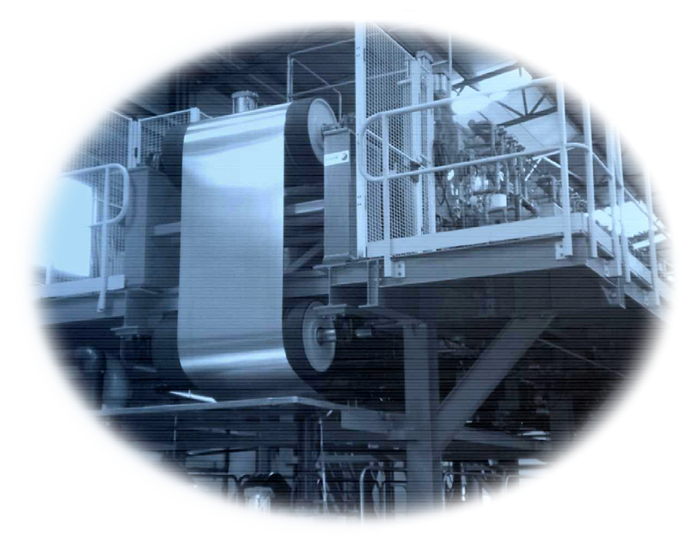GALVANIZING OR GALVALUME PROCESS CHEMICALS.
Galvanizing or Galvalume Process Chemicals
A complete range of products for continuous galvanizing line and galvalume line
GALVANIZING PROCESS
Galvanizing is a process of imparting a sacrificial zinccoating on the iron or steel surface, thereby protecting thesurface from atmosphere. Method of application differs according to the needand availability of measures.
The most popular galvanizing method is Hot Dip Galvanizing which is adaptable to almost all types of fabricated and non-fabricated items.
Flux type Continuous Galvanizing Line is such a kind where iron or steel strips are degreased, pickled and fluxed for surface preparation before dipping into the molten zinc. Post galvanizing a passivation process is required.

Major Steps
ALKALINE CLEANING – Removing oil, grease and soil from steel surface is crucial, otherwise dissolution of iron oxide / scale by pickling will be retarded.
ACID PICKLING – Ferrous metals have a surface coating of metallic oxide and / or scale which must be removed before zinc coating can be applied successfully. Pickling involves immersing the work in an acid to dissolve the scale or oxide film.
FLUXING – Liquid flux is recommended for continuous galvanizing line (C.G.L). It is used directly without any dilution. It has the ability to keep the sheets free from oxides by removing the rust blush prior to dip in the zinc bath. It also improves the zinc – iron adhesion in the galvanizing process.
PASSIVATION – Chromate conversion coating chemical is applied on galvanized iron and zinc –aluminum surfaces. It imparts excellent corrosion resistive coating that protects the underlying surface from weathering.
In case of NOF lines, no fluxing is required. Further, depending on the sheet condition, acid pickling stage may also be omitted. Post NOF galvanizing a passivation process is required.
GALVANIZING CHEMICALS
ALKALINE CLEANING
| PHOSCLEAN 123 | It is a low foaming strong alkaline powdered metal cleaner for spray cum dip degreasing of iron and steel strips, with proven effectiveness in degreasing and removal of dirt and smuts. |
| ETCHINOL S 1121 | It is a low foaming strong alkaline liquid metal cleaner for spray cum dip degreasing of ferrous metals prior to hot dip galvanizing and galvalume, also for cleaning and activating galvanized steel strips prior to chromate conversion. |
| ETCHINOL S 2128 | High-performance low foaming strong alkaline liquid metal cleaner for spray cum dip degreasing of iron and steel strips with proven effectiveness in degreasing and removal of dirt and smuts prior to hot dip galvanizing and galvalume. |
ACID PICKLING
| FERROGUARD 352 | It is a powerful acid inhibitor used in hydrochloric acid pickling baths. When used in acid baths, minimizes metal loss, restricts severe metal pitting and delays the appearance of rust blushing after pickling operation. It forms a thin foam blanket on the surface of the pickling baths and thus minimizes fuming. It inhibits hydrochloric acid pickling baths followed by rinses may be used prior to electroplating, galvanizing, painting and phosphating processes. |
FLUXING
| FLUXOL 336 | It is a liquid flux recommended for continuous galvanizing line (C.G.L). It is used directly without any dilution. The flux is highly stable at galvanizing temperature. Chemically active flux effectively removes impurities from the pickled steel to facilitate trouble free iron-zinc reaction. |
PASSIVATION
| ALIBOND 292 | It is a chemical process, which produces a protective colorless chromate conversion coating on galvanized iron and zinc-aluminum surfaces. The coating protects the surface from de-coloration, corrosion and finger staining. It can be used by dip or spray. |
| PASSILINE 294 | It is a specially designed chrome passivating chemical ideally suitable for galvanized steel and galvalume strips. It can be used by dip or flooding the chemical solution over the strips followed by usual roller squeezing and drying. The treated surfaces protect the metal from corrosion and staining for a long period of time. |
| PASSILINE 1293 | Formulated for surface passivation of galvanized steel or galvalume in sheet or strip line operations. Applied to the strip by immersing the strip or flooding the strip with the treatment solution. Removal of excess solution is then accomplished using squeeze roller. Protect the galvanized steel or galvalume surface from corrosion and metal staining during storage and shipment. |
| PASSILINE 1291 | Non hexavalent chromium-based formulation for surface passivation ofgalvanized steel or galvalume in sheet or strip line operation. It protects thegalvanized steel or galvalume surface from corrosion and metal staining duringstorage and shipment. |
GALVALUME PROCESS
Galvalume is a process of imparting a sacrificial aluminium-zinc coating on the iron or steel surface, thereby protecting the surface from atmosphere. Method of application differs according to the need and availability of measures.
Major Steps
ALKALINE CLEANING – Removing oil, grease and soil from steel surface is crucial, otherwise dissolution of iron oxide / scale by pickling will be retarded.
THIN ORGANIC COATING (TOC) – Thin Organic Coating (TOC) chemical is formulated for continuous galvalume line application. It forms an organic coating on treated surface that supports an anti-fingerprint property as well as better corrosion resistance.
GALVALUME CHEMICALS
ALKALINE CLEANING
| ETCHINOL S 1121 | It is a low foaming strong alkaline liquid metal cleaner for spray cum dip degreasing of ferrous metals prior to hot dip galvanizing and galvalume, also for cleaning and activating galvanized steel strips prior to chromate conversion. |
| PHOSCLEAN 05 | It is a silica free heavy-duty caustic based alkaline cleaner used for electrolytic cleaning of ferrousmetals and suitable for continuous process. It is ideally suitable for hot dip coating and electrolytic tinning line. |
THIN ORGANIC COATING
| PASSICOAT 1400 | It is a Thin Organic Coating (TOC) chemical which contains low hexavalent chromium, is formulated for continuous galvanizing line application, especially on galvalume substrates. Application is generally with reverse roll coating and other applications can also be applied. |
